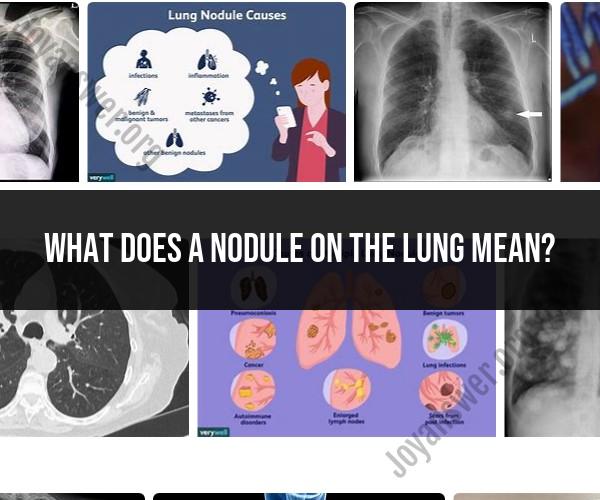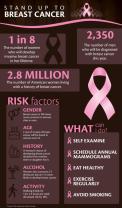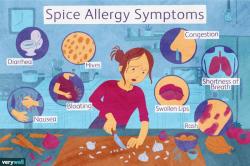What does a nodule on the lung mean?
A lung nodule is a small, round or oval-shaped growth or lesion that appears as a spot on a chest X-ray or CT scan. These nodules can vary in size, ranging from less than 3 centimeters (about 1 inch) to a few centimeters in diameter. The presence of a lung nodule can have various implications, and its meaning depends on several factors, including its size, appearance, and the patient's medical history. Here are some possible interpretations of a lung nodule:
Benign Nodule: Many lung nodules are benign, meaning they are non-cancerous. Benign nodules can be caused by a variety of factors, including infections, inflammation, or scars from previous lung injuries. These nodules often require no treatment and may be monitored over time to ensure they do not change or grow.
Infectious Nodule: Some lung nodules can develop due to infections such as fungal infections, bacterial pneumonia, or tuberculosis. Treating the underlying infection is usually the primary approach, and the nodule may resolve once the infection is treated.
Granuloma: A granuloma is a specific type of nodule that forms as a result of chronic inflammation, often in response to an infection or exposure to certain substances like asbestos. Granulomas are typically non-cancerous and may not require treatment.
Suspicious Nodule: If a lung nodule appears suspicious based on its size, shape, or characteristics, it may be considered for further evaluation. Characteristics that might raise suspicion include rapid growth, irregular shape, or a size larger than 3 centimeters. Further evaluation may involve additional imaging tests, such as a PET scan, or a biopsy to determine if the nodule is cancerous.
Lung Cancer: In some cases, a lung nodule can be an early sign of lung cancer. Lung cancer nodules may be malignant (cancerous) and can grow and spread if left untreated. If a nodule is determined to be cancerous, treatment options such as surgery, chemotherapy, radiation therapy, or targeted therapy may be considered based on the type and stage of lung cancer.
It's essential to consult with a healthcare professional, such as a pulmonologist or oncologist, if a lung nodule is detected. They will consider your medical history, conduct further tests, and determine the appropriate course of action, whether it involves monitoring, treatment, or additional diagnostics. The presence of a lung nodule does not automatically mean cancer, but it does warrant careful evaluation to ensure the best possible outcome.
Lung Nodules Explained: Understanding the Significance and Implications
Lung nodules are small, rounded masses of tissue that appear on the lungs when viewed on a chest X-ray or CT scan. They can be solid, part-solid, or ground-glass in appearance. Lung nodules are very common, and most of them are benign (non-cancerous). However, some lung nodules can be malignant (cancerous).
The significance and implications of a lung nodule depend on a number of factors, including its size, shape, location, and appearance on imaging studies. Lung nodules that are small and solid are more likely to be benign, while lung nodules that are large, solid, and located in the upper lobes of the lungs are more likely to be malignant.
Pulmonary Nodules: What Does a Lung Nodule Indicate?
A lung nodule can indicate a variety of things, including:
- Infection: Infections such as tuberculosis, pneumonia, and fungal infections can cause lung nodules.
- Inflammation: Inflammatory conditions such as sarcoidosis and rheumatoid arthritis can also cause lung nodules.
- Cancer: Lung cancer is the most serious condition that can cause a lung nodule.
Nodules in the Lungs: Deciphering Their Meaning and Evaluation
To decipher the meaning of a lung nodule and to determine whether it is benign or malignant, doctors will typically order additional imaging tests, such as a high-resolution CT scan or a PET scan. If the imaging tests are inconclusive, a biopsy of the nodule may be necessary to make a definitive diagnosis.
If a lung nodule is found to be benign, doctors will typically monitor it with regular imaging tests to make sure that it does not grow or change in appearance. If a lung nodule is found to be malignant, doctors will recommend treatment, which may include surgery, radiation therapy, chemotherapy, or a combination of these treatments.
If you have been diagnosed with a lung nodule, it is important to talk to your doctor about the significance and implications of your specific nodule. Your doctor can help you to develop a plan to monitor or treat your nodule, depending on its characteristics.













